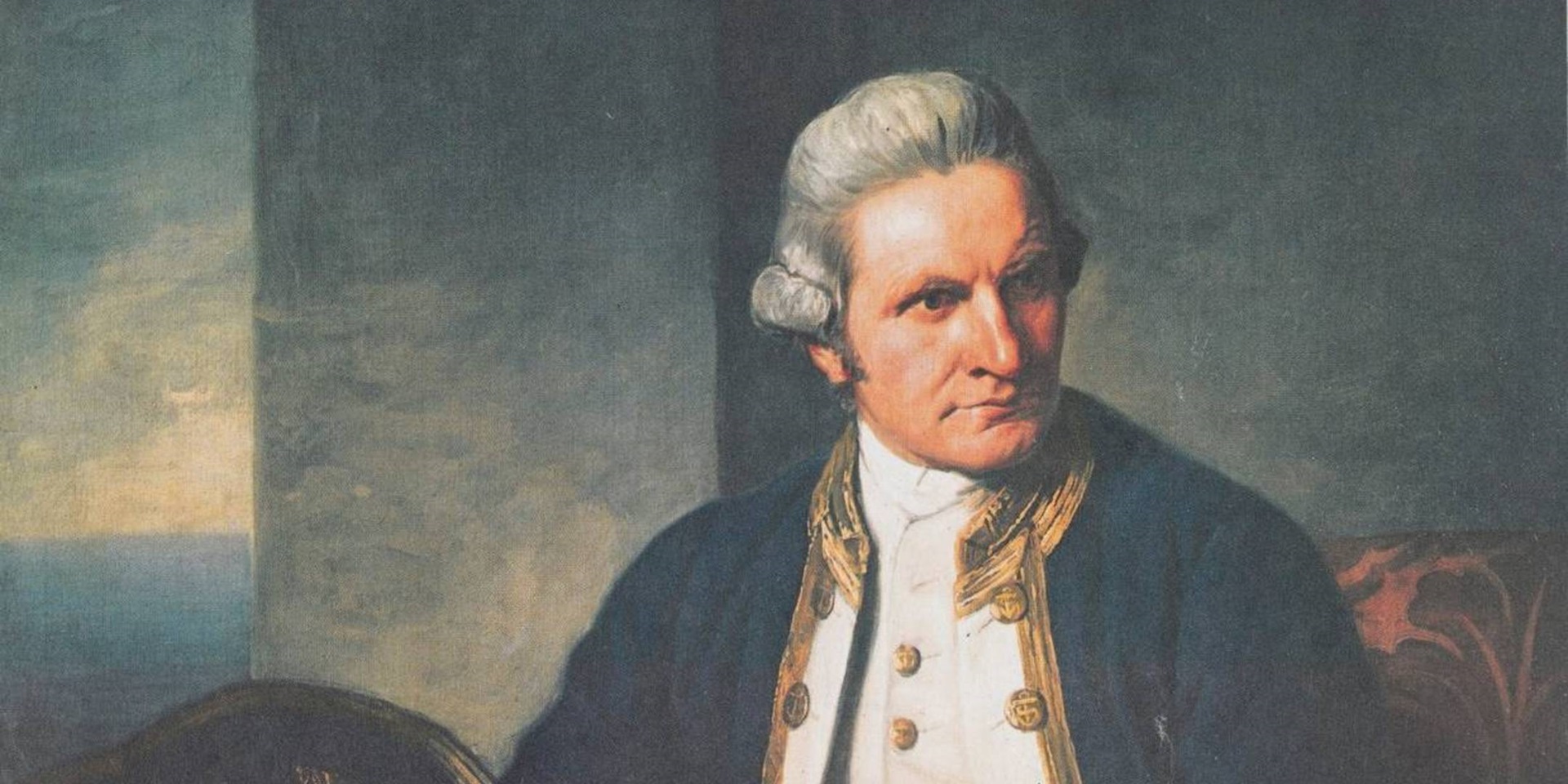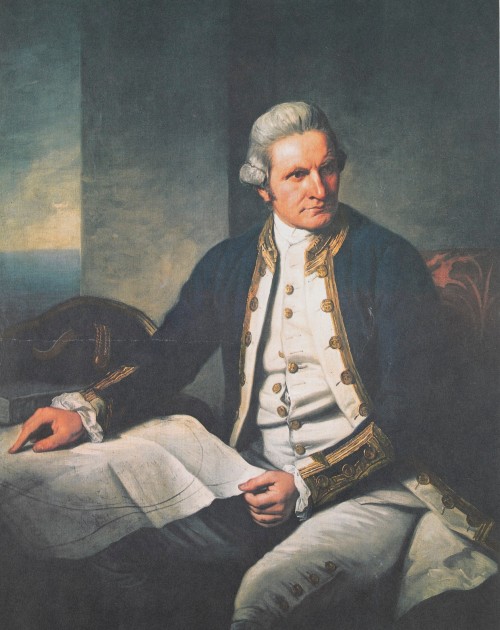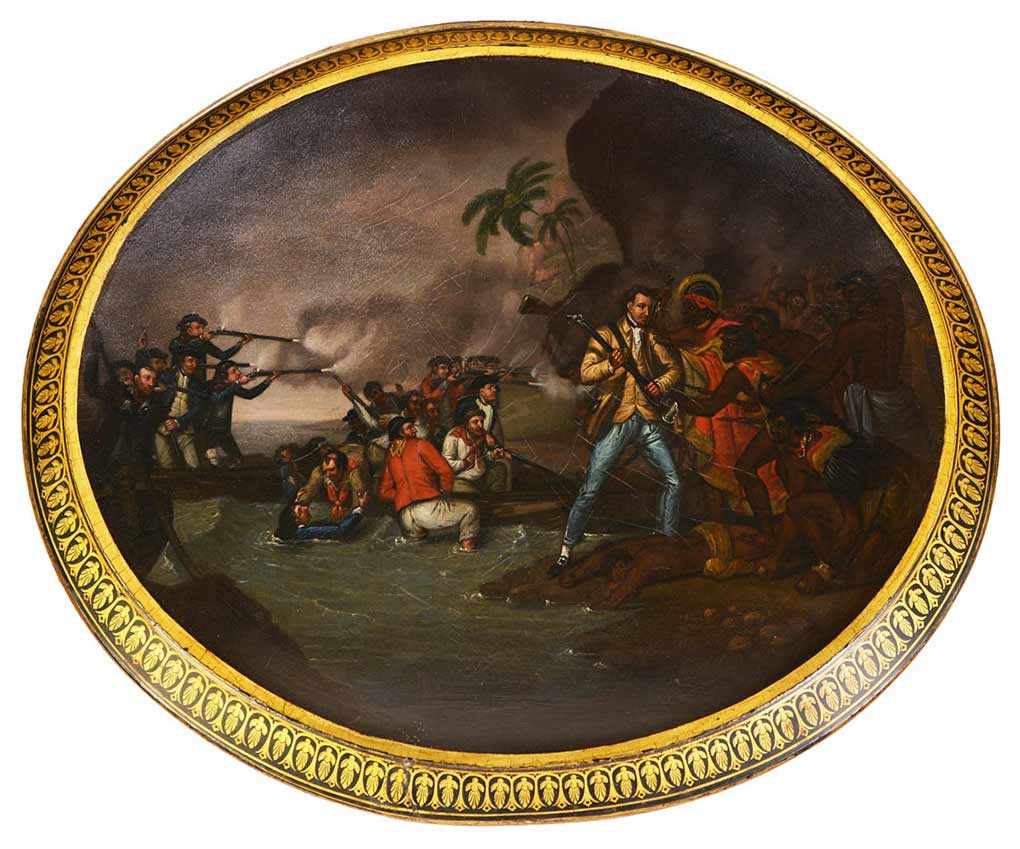
For someone who looms so large in the Australian consciousness, there’s a lot about James Cook that Australians get wrong. Dr Stephen Gapps and Steve Riethoff straighten out some of the misconceptions.
Myth 1 – Cook was the first European to discover Australia
According to a recent survey 31 per cent of Australians think that James Cook was the first European to find Australia.1
The fact is that Cook’s 1770 voyage followed more than a dozen previous encounters by Europeans in the north-west, west and south of the continent throughout the 17th century – all of them more than a hundred years before Cook’s visit. There may even have been earlier Portuguese visits in the 16th century, and some historians have suggested that the Chinese Grand Fleet, under Admiral Zheng He, may have arrived here in the 15th century. Visiting long before Cook, men such as Willem Janszoon, Luis Vaz de Torres, Dirk Hartog, Frederick de Houtman and Abel Tasman are certainly not household names, as are Cook and Endeavour.
Cook can claim a couple of other ‘firsts’, though: in 1770, he was the first European to chart the east coast and the Endeavour crew were the first Europeans known to have landed on the east coast.
In fact, the oldest known foreign visitors to Australia were from modern-day Indonesia and Papua New Guinea. Makassan traders had been visiting and trading with people in northern Australia for hundreds of years and dugout canoes were traded from the Sepik River to the Torres Strait Islands for generations before Cook arrived there.
No European ‘discovered’ Australia. The Aboriginal and Torres Strait Islander inhabitants of this continent managed that all by themselves – some 60,000 years before any European turned up.

Captain Cook by Nathaniel Dance (1735-1811), published 1969. State Library of Victoria, H32508
Myth 2 – Cook and Endeavour were in the First Fleet and brought convicts to Australia
According to the same survey, 47 per cent of Australians think that Endeavour arrived in Australia with the First Fleet in 1788 – and they are 100 per cent wrong!2
The First Fleet, under Captain Arthur Phillip, arrived in Botany Bay between 18 and 20 January 1788. By that time, Cook had been dead for nine years, Endeavour had been renamed Lord Sandwich, and in 1778, during the American War of Independence, the ship had been scuttled in Newport Harbor, Rhode Island, as an underwater defence against French attack.
The way many non-Indigenous Australians mix up Cook and Phillip is understandable – for many years Cook’s arrival was seen as a better foundational moment than a fleet full of convicts, and so 29 April (the date when Endeavour arrived at Botany Bay in 1770) was officially celebrated as the origin of white settlement. From the 1930s, the focus of national commemorations turned towards the First Fleet – but often didn’t mention the convicts. It wasn’t until the ‘convict stain’ began to be erased in the 1970s that the First Fleet became widely associated with the beginning of modern Australia.
In fact, Cook was the representative of the British Crown and claimed possession of the east coast of Australia on behalf of the Crown, naming it New South Wales. Cook’s arrival has therefore become the symbol of the European invasion and occupation of the continent, particularly for First Nations people.
Myth 3 – January 26 marks Cook’s arrival
Another fallacy. On 29 April 1770, Cook arrived in Stingray Bay (which he later changed to Botanist Bay, then Botany Bay – the area is now the Kamay Botany Bay National Park). January 26 was when the First Fleet arrived in Sydney Cove – 18 years later, in 1788. Governor Phillip moved the planned settlement from Botany Bay to Port Jackson (Sydney Harbour). Strangely, perhaps, the usually meticulous cartographer Cook didn’t even enter what Phillip called ‘the finest harbour in the world’, but merely sailed past.
Myth 4 – Cook circumnavigated Australia
That’s a ‘no’. Cook saw only the east coast of the continent, and was several thousand kilometres short of a circumnavigation.
Cook sighted the mainland near what is now called Point Hicks, in Victoria, and sailed north up the east coast before continuing to Batavia (now Jakarta, Indonesia). He didn’t ever see the north and west coasts of the continent, and the only southern region he encountered was on a later trip, when he sailed Tasmania’s east coast.
The first European to circumnavigate Australia was Matthew Flinders, from 1801 to 1803. Flinders was accompanied by Bungaree, the first Indigenous Australian known to have circumnavigated the continent.
Myth 5 – Cook lived in Captain Cook’s Cottage in Melbourne
This is a chronological impossibility. Cook died in 1779 – nine years before Europeans settled in Australia, and decades before Melbourne was founded in 1835.
The cottage in question was originally located in Yorkshire, England, where Cook’s parents lived from 1755. James Cook never lived in the cottage – he’d been away from home for almost 10 years by the time it was built. But this connection to the Cook family was enough to prompt philanthropist and Cook enthusiast, Sir Wilfred Russell Grimwade, to transport the cottage to the other side of the world, where it was rebuilt in Fitzroy Gardens in 1934.
Myth 6 – Cook was instrumental in deciding to establish the colony in New South Wales
Another fallacy. After returning to London following their first Pacific voyage, both Cook and Banks wrote of their experiences in reports and in published journals, but Cook had very little to do with the political workings in London.
James Matra – who had been a midshipman on Endeavour (under the name of ‘Magra’) and who later became a diplomat – proposed the idea of a colony in New South Wales in August 1783, with the support of Joseph Banks. The American War of Independence had been under way since 1775, and Matra’s suggestion (which was rejected) was that the colony could become a place for Americans who were loyal to Britain. Matra didn’t mention convicts, but later amended the proposal to include them alongside free settlers.

Japanned papier-mâché tea tray bearing the patent mark of Henry Clay and painted with a scene of the death of Captain Cook. ANMM Collection, 00055335
Myth 7 – ‘Captain Cook’ charted the east coast of Australia
Actually, he was ‘Lieutenant Cook’ at the time. While the officer in command of a ship is often assumed to be a captain, this is not always the case, particularly in smaller naval vessels. When Cook set sail in 1768 on his first voyage aboard Endeavour he held the rank of lieutenant. Soon after his return to England in 1771 he was promoted to the rank of commander. In fact, he never actually held the rank of captain, but in 1775 was promoted to the higher rank of post-captain.
Myth 8 – Captain Cook was eaten by cannibals
The Hawaiian Islanders who killed Captain Cook (on Valentines’ day in 1779) were not cannibals. They believed the power of a great man lived in his bones, so they cooked parts of Cook’s body to easily remove them.
References
1 Research conducted by the Department of Communications and the Arts, 2019.
2 Ibid.
Voyage 1 (1768–1771): ship Endeavour
Route: London – Madiera – Rio de Janeiro – Cape Horn – Tuamotu Island – Tahiti – Society Islands – New Zealand – New Holland (Australia) – East Timor – Java – Batavia – Cape of Good Hope – St Helena – Ascension – London
Voyage 2 (1772–1775): ships Resolution and Adventure
Route: London – Madeira – Cape of Good Hope – New Zealand – Tuamotu Island – Tahiti – Society Islands – Friendly Islands (Tonga) – New Zealand – Easter Island – Marquesas Island – Tahiti – Society Islands – New Hebrides – New Caledonia – New Zealand – Cape Horn – South Georgia – Cape of Good Hope – St Helena – Ascension – Azores – London
Voyage 3 (1776–1780): ships Resolution and Discovery
Route: London – Tenerife – Cape of Good Hope – Prince Edward Island – Kerguelen Island – Van Diemen’s Land – New Zealand – Tonga – Tahiti – Christmas Island – Sandwich Islands (Hawaiian Islands) – Nootka Sound – Cook Inlet – Unalaska – Bering Strait – Arctic Sea – Unalaska – Hawaii (where Cook was murdered).
This article was originally published in Signals 129
